CUC100: Resource Usage and Sustainability in the Workplace - ENPS
VerifiedAdded on 2022/10/17
|13
|888
|12
Report
AI Summary
This report focuses on resource usage and sustainability practices within Eltham North Primary School (ENPS). It begins by defining sustainability, referencing the Australian Curriculum and the World Commission on Environment and Development. The report then outlines the school's sustainability concerns, categorizing them into environmental (energy, water, waste, biodiversity), social (responsible resource management, sustainability education), and economic (costs of energy-efficient equipment and sustainability initiatives) aspects. The core of the report proposes solutions to improve sustainability, primarily through energy conservation measures such as energy audits, efficient lighting, and alternative energy sources. It also addresses social and economic impacts by promoting waste reduction, recycling, and student engagement in conservation programs. The report concludes by emphasizing the importance of sustainability in addressing climate change and resource depletion, highlighting the role of schools in imparting sustainability knowledge and skills, and promoting sustainable practices within the community, specifically referencing ENPS's successful initiatives and programs.
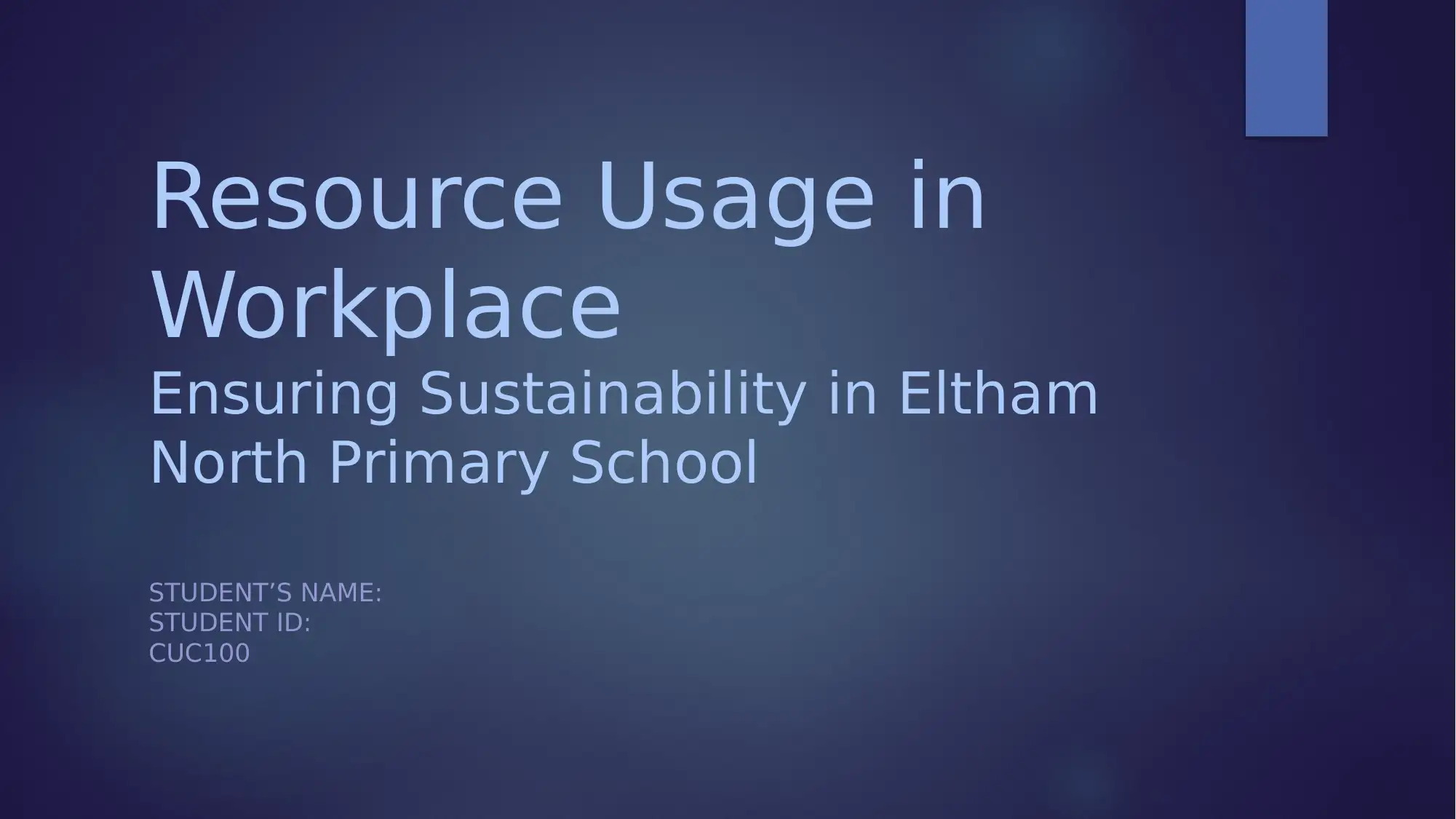
Resource Usage in
Workplace
Ensuring Sustainability in Eltham
North Primary School
STUDENT’S NAME:
STUDENT ID:
CUC100
Workplace
Ensuring Sustainability in Eltham
North Primary School
STUDENT’S NAME:
STUDENT ID:
CUC100
Paraphrase This Document
Need a fresh take? Get an instant paraphrase of this document with our AI Paraphraser
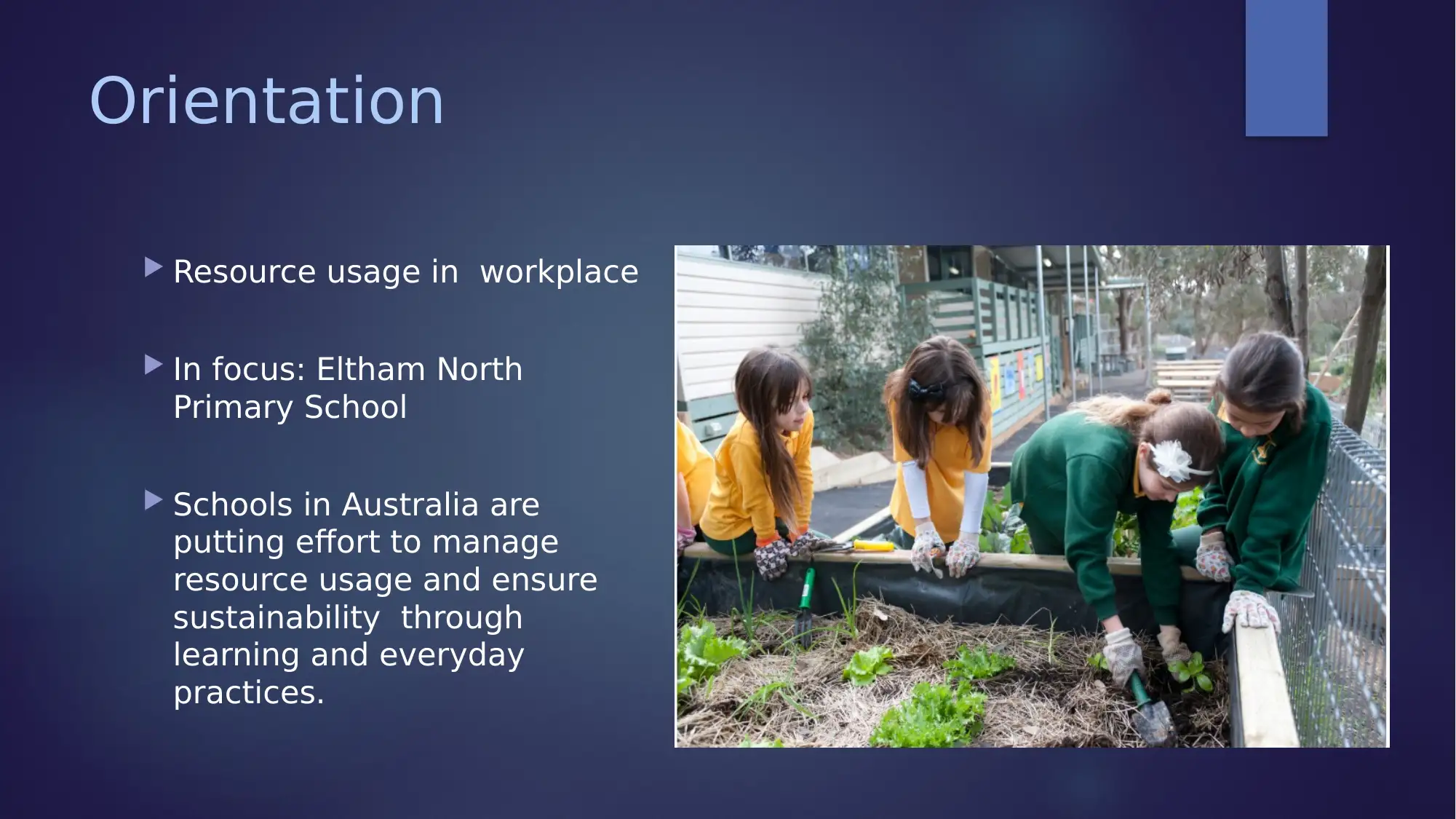
Orientation
Resource usage in workplace
In focus: Eltham North
Primary School
Schools in Australia are
putting effort to manage
resource usage and ensure
sustainability through
learning and everyday
practices.
Resource usage in workplace
In focus: Eltham North
Primary School
Schools in Australia are
putting effort to manage
resource usage and ensure
sustainability through
learning and everyday
practices.
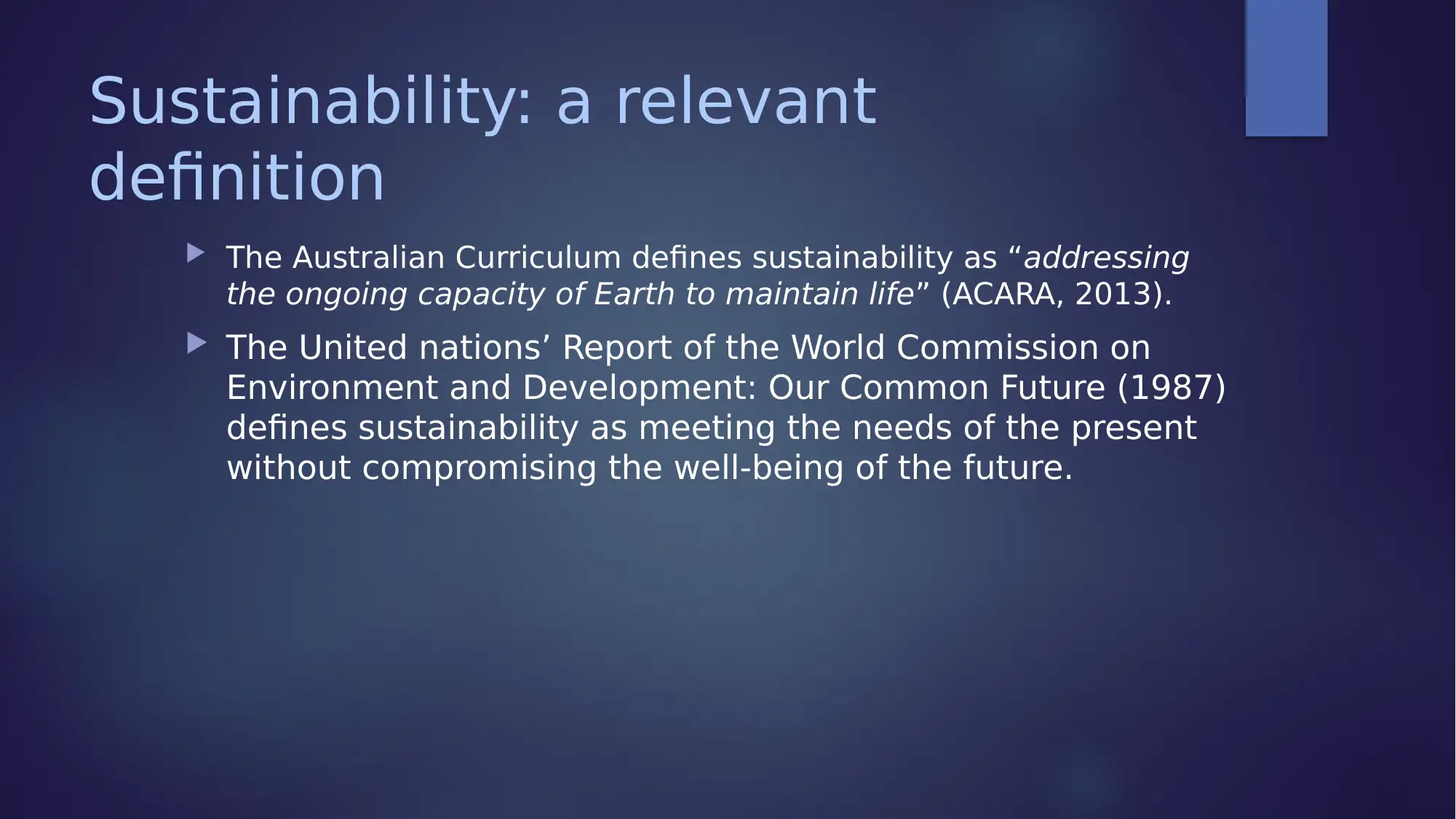
Sustainability: a relevant
definition
The Australian Curriculum defines sustainability as “addressing
the ongoing capacity of Earth to maintain life” (ACARA, 2013).
The United nations’ Report of the World Commission on
Environment and Development: Our Common Future (1987)
defines sustainability as meeting the needs of the present
without compromising the well-being of the future.
definition
The Australian Curriculum defines sustainability as “addressing
the ongoing capacity of Earth to maintain life” (ACARA, 2013).
The United nations’ Report of the World Commission on
Environment and Development: Our Common Future (1987)
defines sustainability as meeting the needs of the present
without compromising the well-being of the future.
⊘ This is a preview!⊘
Do you want full access?
Subscribe today to unlock all pages.

Trusted by 1+ million students worldwide
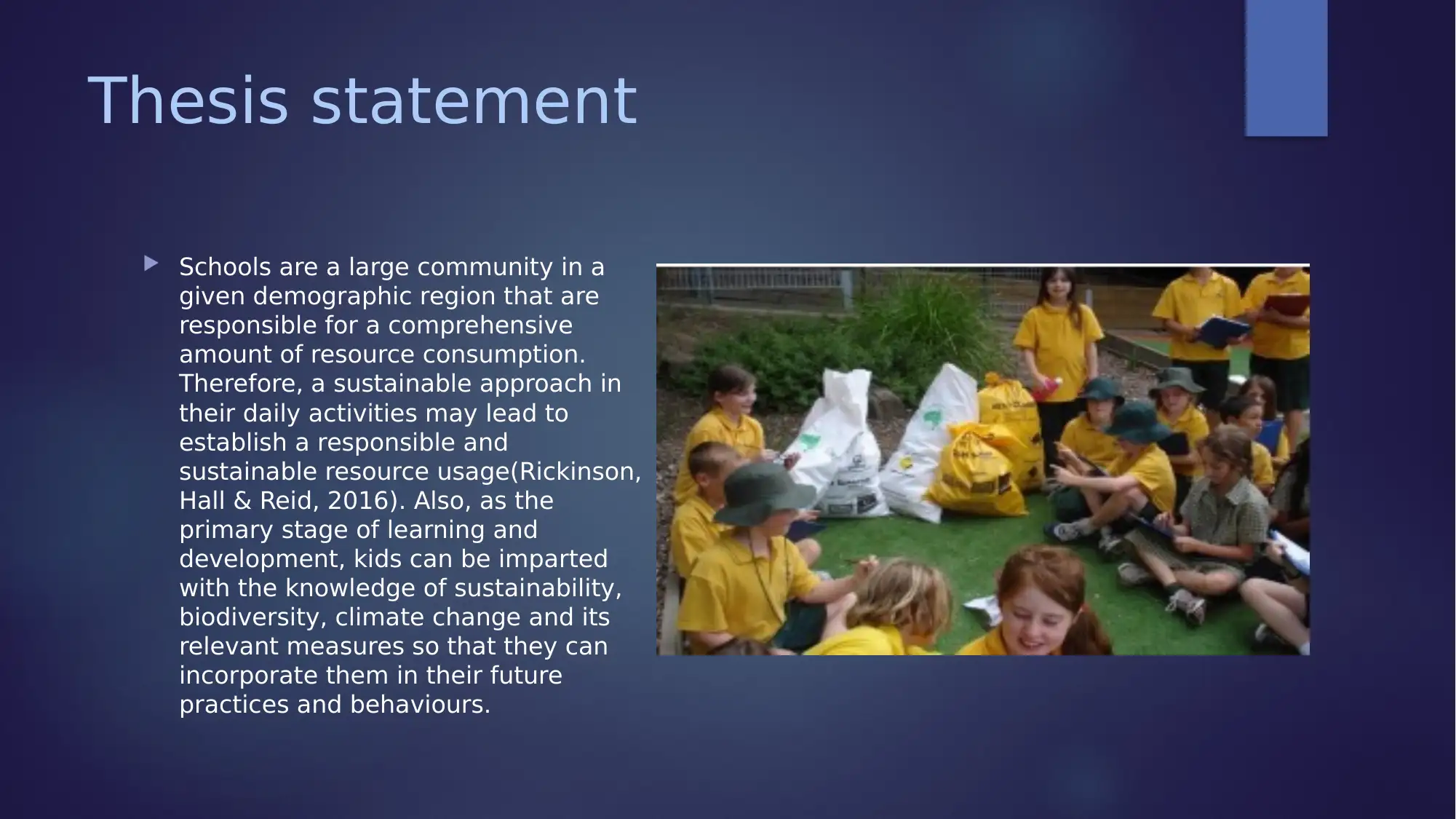
Thesis statement
Schools are a large community in a
given demographic region that are
responsible for a comprehensive
amount of resource consumption.
Therefore, a sustainable approach in
their daily activities may lead to
establish a responsible and
sustainable resource usage(Rickinson,
Hall & Reid, 2016). Also, as the
primary stage of learning and
development, kids can be imparted
with the knowledge of sustainability,
biodiversity, climate change and its
relevant measures so that they can
incorporate them in their future
practices and behaviours.
Schools are a large community in a
given demographic region that are
responsible for a comprehensive
amount of resource consumption.
Therefore, a sustainable approach in
their daily activities may lead to
establish a responsible and
sustainable resource usage(Rickinson,
Hall & Reid, 2016). Also, as the
primary stage of learning and
development, kids can be imparted
with the knowledge of sustainability,
biodiversity, climate change and its
relevant measures so that they can
incorporate them in their future
practices and behaviours.
Paraphrase This Document
Need a fresh take? Get an instant paraphrase of this document with our AI Paraphraser

Resource Usage in
School
Overview of scenario & definition
Stakeholders
Students and Teachers
Parents and associated
community
Overview
ENPS tries to reduce carbon and
water footprints and promote
sustainable practices through
extra-curricular practices
Sustainability concerns
Economic
Maintenance and cost-
effectiveness for alternative
energy sources
Promoting energy efficient
equipment may incur more cost
Social
Imparting knowledge and good
practices to children
Managing local and natural
resources responsibly
Environmental
Reducing energy usage
Water consumption
Waste management
How sustainability in this
scenario could be improved
Responses to identified issues
Monitor and control waste
Reducing water and energy
consumption
Promoting biodiversity
conservation through curriculum
and extra-curricular programs
Implementing these responses
Conducting energy audit in
school
Screening and banning wrappers
and plastics in school premises
Use alternative energy source
Control energy consumption in
lights, heating and colloing
systems, computers and gym
School
Overview of scenario & definition
Stakeholders
Students and Teachers
Parents and associated
community
Overview
ENPS tries to reduce carbon and
water footprints and promote
sustainable practices through
extra-curricular practices
Sustainability concerns
Economic
Maintenance and cost-
effectiveness for alternative
energy sources
Promoting energy efficient
equipment may incur more cost
Social
Imparting knowledge and good
practices to children
Managing local and natural
resources responsibly
Environmental
Reducing energy usage
Water consumption
Waste management
How sustainability in this
scenario could be improved
Responses to identified issues
Monitor and control waste
Reducing water and energy
consumption
Promoting biodiversity
conservation through curriculum
and extra-curricular programs
Implementing these responses
Conducting energy audit in
school
Screening and banning wrappers
and plastics in school premises
Use alternative energy source
Control energy consumption in
lights, heating and colloing
systems, computers and gym
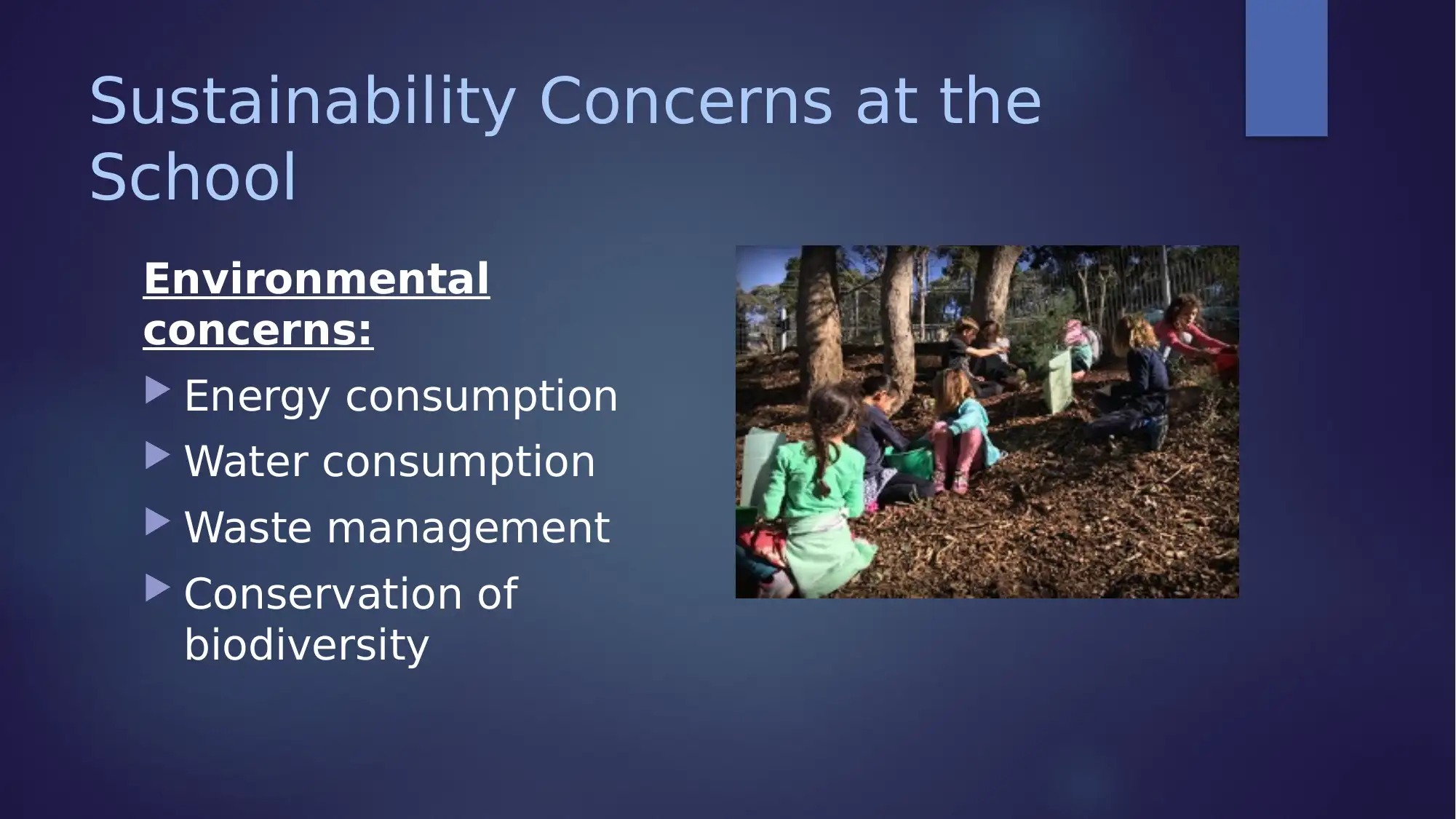
Sustainability Concerns at the
School
Environmental
concerns:
Energy consumption
Water consumption
Waste management
Conservation of
biodiversity
School
Environmental
concerns:
Energy consumption
Water consumption
Waste management
Conservation of
biodiversity
⊘ This is a preview!⊘
Do you want full access?
Subscribe today to unlock all pages.

Trusted by 1+ million students worldwide
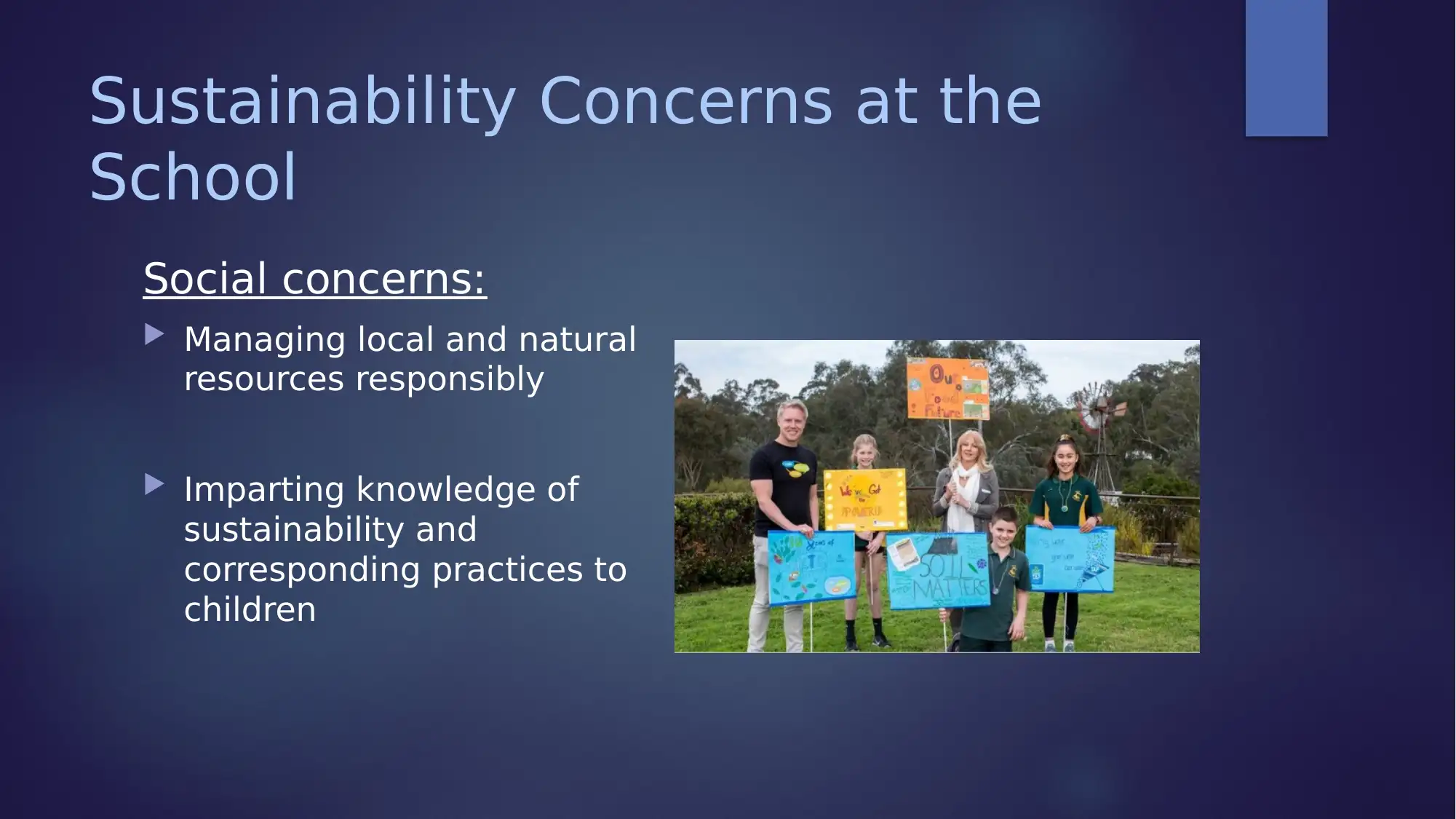
Sustainability Concerns at the
School
Social concerns:
Managing local and natural
resources responsibly
Imparting knowledge of
sustainability and
corresponding practices to
children
School
Social concerns:
Managing local and natural
resources responsibly
Imparting knowledge of
sustainability and
corresponding practices to
children
Paraphrase This Document
Need a fresh take? Get an instant paraphrase of this document with our AI Paraphraser
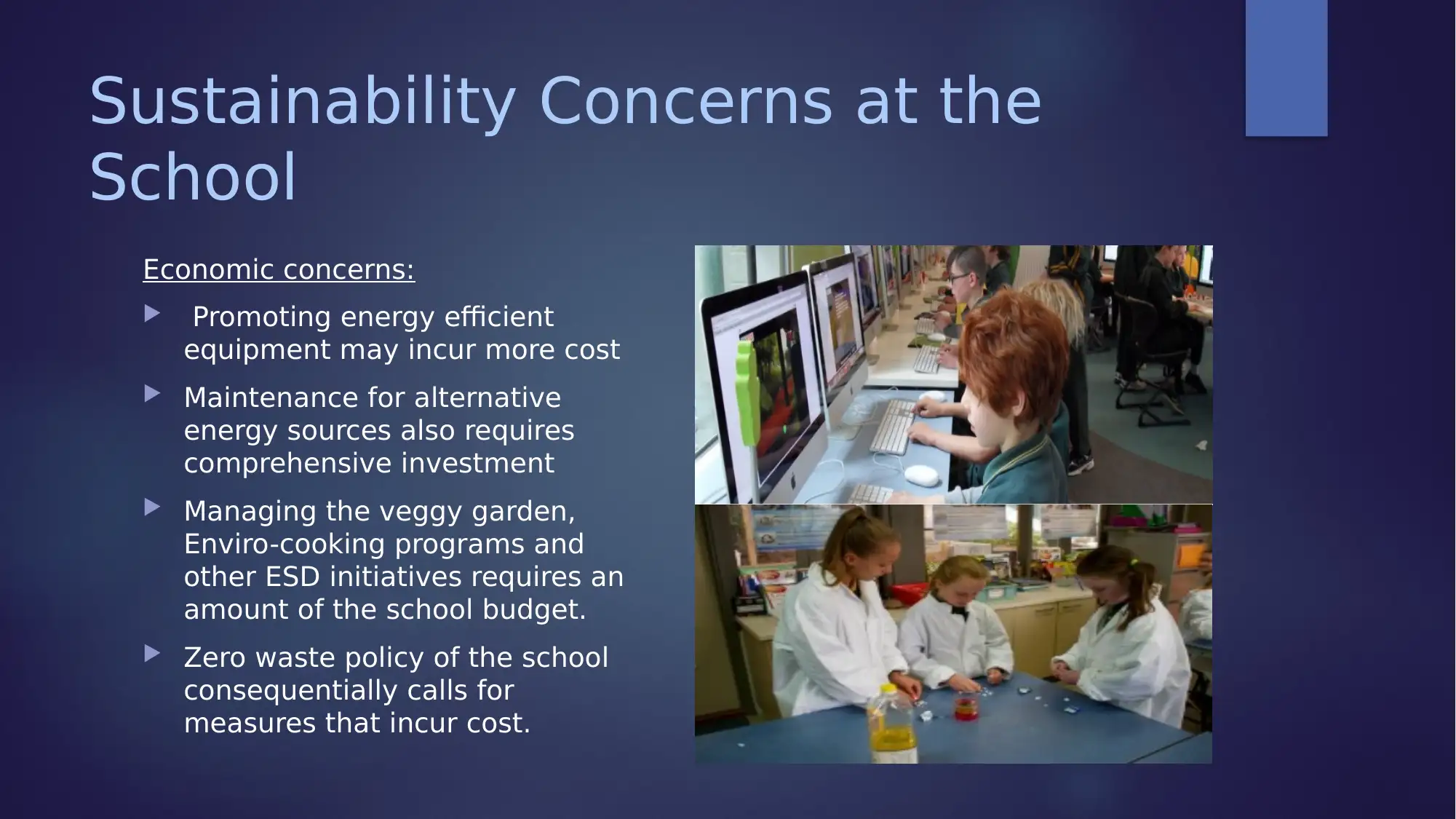
Sustainability Concerns at the
School
Economic concerns:
Promoting energy efficient
equipment may incur more cost
Maintenance for alternative
energy sources also requires
comprehensive investment
Managing the veggy garden,
Enviro-cooking programs and
other ESD initiatives requires an
amount of the school budget.
Zero waste policy of the school
consequentially calls for
measures that incur cost.
School
Economic concerns:
Promoting energy efficient
equipment may incur more cost
Maintenance for alternative
energy sources also requires
comprehensive investment
Managing the veggy garden,
Enviro-cooking programs and
other ESD initiatives requires an
amount of the school budget.
Zero waste policy of the school
consequentially calls for
measures that incur cost.
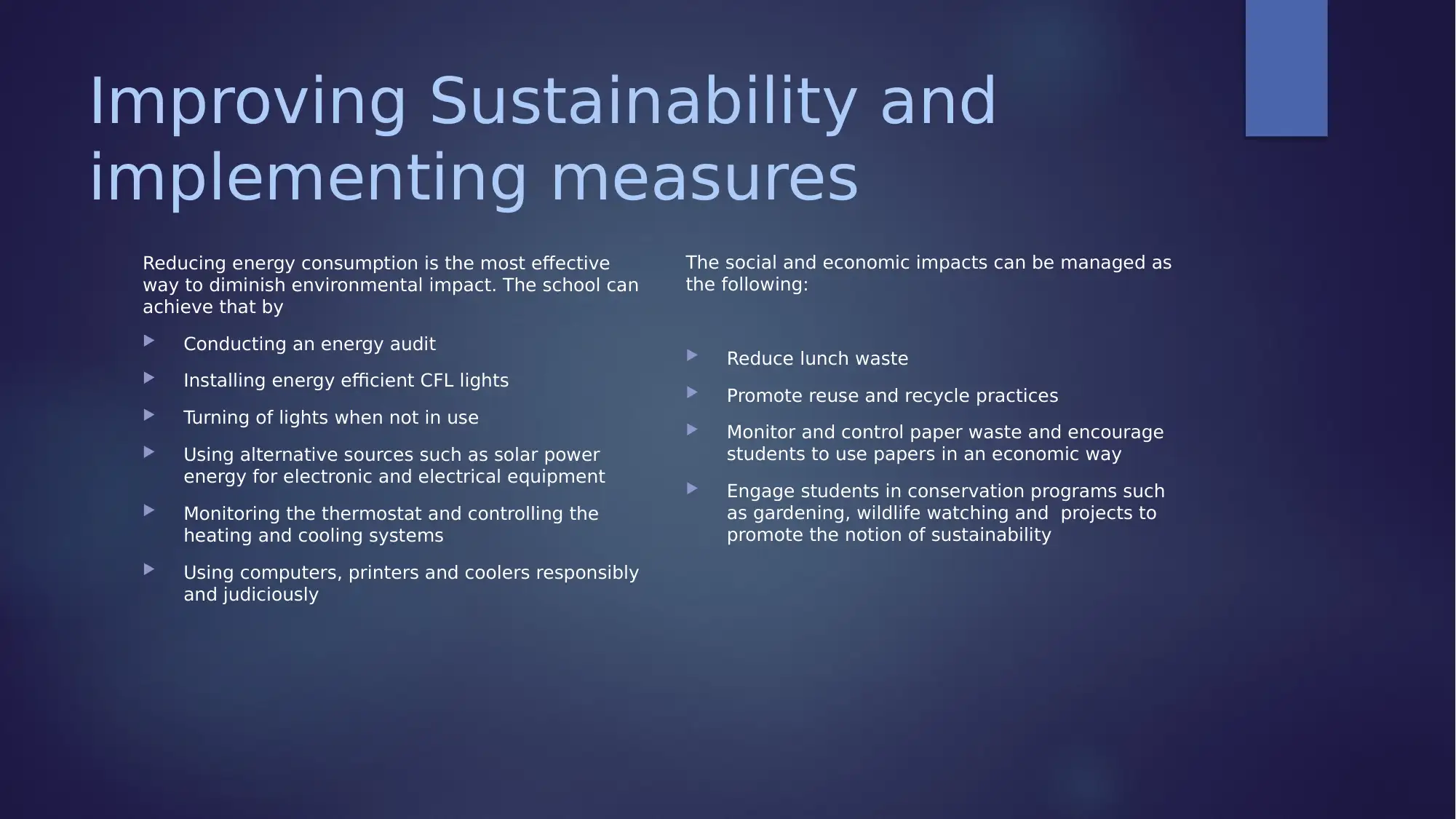
Improving Sustainability and
implementing measures
Reducing energy consumption is the most effective
way to diminish environmental impact. The school can
achieve that by
Conducting an energy audit
Installing energy efficient CFL lights
Turning of lights when not in use
Using alternative sources such as solar power
energy for electronic and electrical equipment
Monitoring the thermostat and controlling the
heating and cooling systems
Using computers, printers and coolers responsibly
and judiciously
The social and economic impacts can be managed as
the following:
Reduce lunch waste
Promote reuse and recycle practices
Monitor and control paper waste and encourage
students to use papers in an economic way
Engage students in conservation programs such
as gardening, wildlife watching and projects to
promote the notion of sustainability
implementing measures
Reducing energy consumption is the most effective
way to diminish environmental impact. The school can
achieve that by
Conducting an energy audit
Installing energy efficient CFL lights
Turning of lights when not in use
Using alternative sources such as solar power
energy for electronic and electrical equipment
Monitoring the thermostat and controlling the
heating and cooling systems
Using computers, printers and coolers responsibly
and judiciously
The social and economic impacts can be managed as
the following:
Reduce lunch waste
Promote reuse and recycle practices
Monitor and control paper waste and encourage
students to use papers in an economic way
Engage students in conservation programs such
as gardening, wildlife watching and projects to
promote the notion of sustainability
⊘ This is a preview!⊘
Do you want full access?
Subscribe today to unlock all pages.

Trusted by 1+ million students worldwide
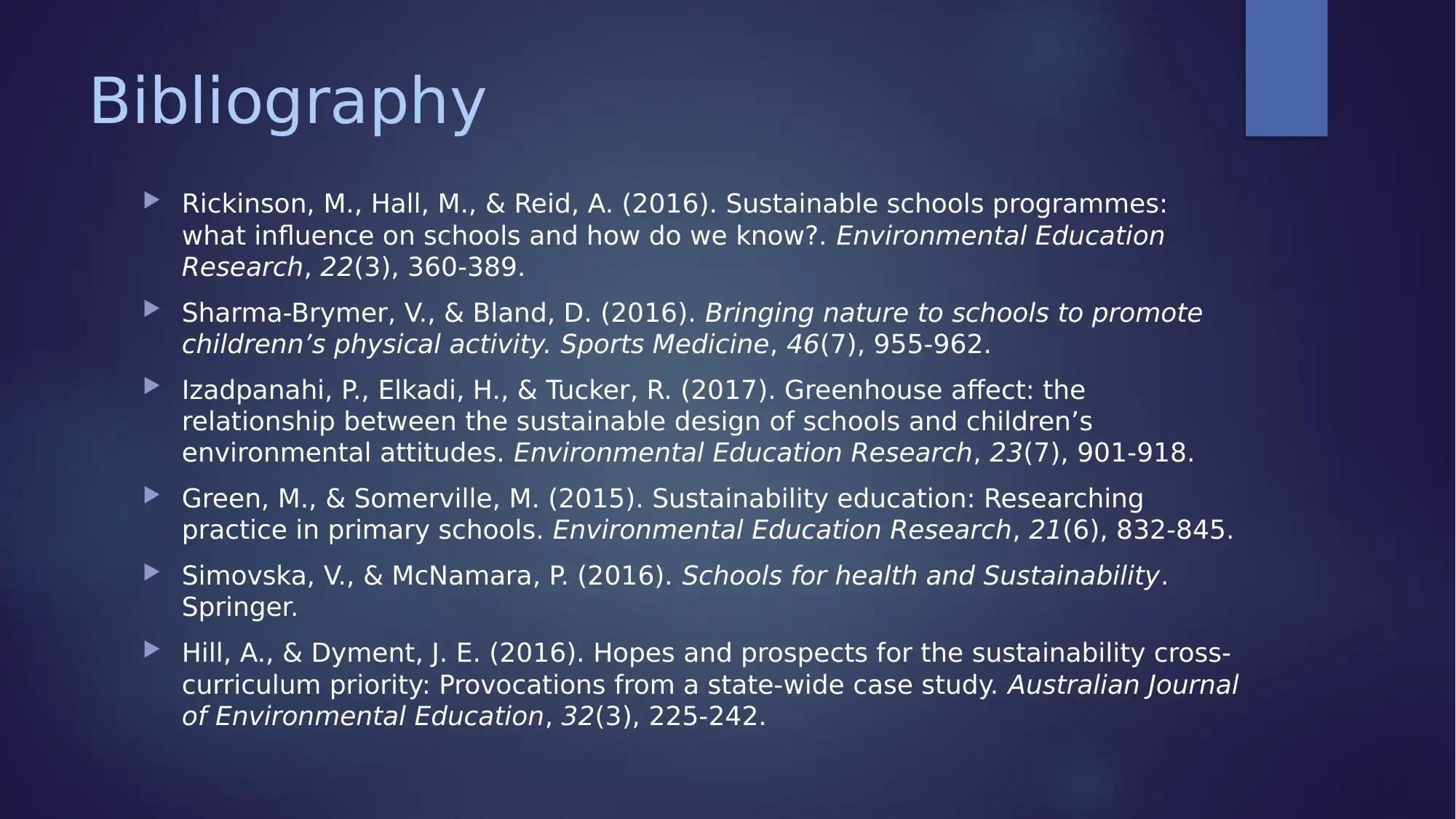
Bibliography
Rickinson, M., Hall, M., & Reid, A. (2016). Sustainable schools programmes:
what influence on schools and how do we know?. Environmental Education
Research, 22(3), 360-389.
Sharma-Brymer, V., & Bland, D. (2016). Bringing nature to schools to promote
childrenn’s physical activity. Sports Medicine, 46(7), 955-962.
Izadpanahi, P., Elkadi, H., & Tucker, R. (2017). Greenhouse affect: the
relationship between the sustainable design of schools and children’s
environmental attitudes. Environmental Education Research, 23(7), 901-918.
Green, M., & Somerville, M. (2015). Sustainability education: Researching
practice in primary schools. Environmental Education Research, 21(6), 832-845.
Simovska, V., & McNamara, P. (2016). Schools for health and Sustainability.
Springer.
Hill, A., & Dyment, J. E. (2016). Hopes and prospects for the sustainability cross-
curriculum priority: Provocations from a state-wide case study. Australian Journal
of Environmental Education, 32(3), 225-242.
Rickinson, M., Hall, M., & Reid, A. (2016). Sustainable schools programmes:
what influence on schools and how do we know?. Environmental Education
Research, 22(3), 360-389.
Sharma-Brymer, V., & Bland, D. (2016). Bringing nature to schools to promote
childrenn’s physical activity. Sports Medicine, 46(7), 955-962.
Izadpanahi, P., Elkadi, H., & Tucker, R. (2017). Greenhouse affect: the
relationship between the sustainable design of schools and children’s
environmental attitudes. Environmental Education Research, 23(7), 901-918.
Green, M., & Somerville, M. (2015). Sustainability education: Researching
practice in primary schools. Environmental Education Research, 21(6), 832-845.
Simovska, V., & McNamara, P. (2016). Schools for health and Sustainability.
Springer.
Hill, A., & Dyment, J. E. (2016). Hopes and prospects for the sustainability cross-
curriculum priority: Provocations from a state-wide case study. Australian Journal
of Environmental Education, 32(3), 225-242.
Paraphrase This Document
Need a fresh take? Get an instant paraphrase of this document with our AI Paraphraser
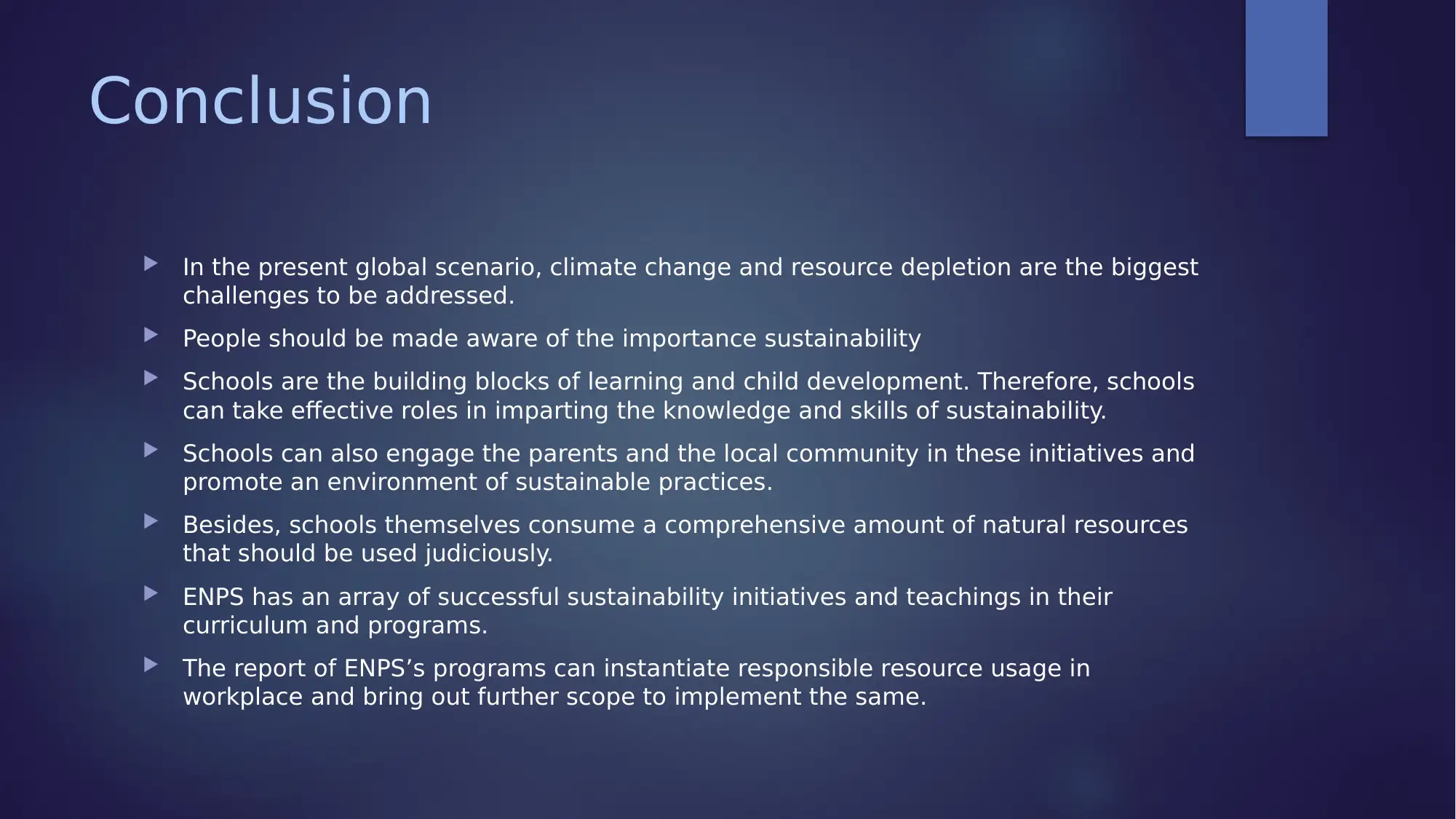
Conclusion
In the present global scenario, climate change and resource depletion are the biggest
challenges to be addressed.
People should be made aware of the importance sustainability
Schools are the building blocks of learning and child development. Therefore, schools
can take effective roles in imparting the knowledge and skills of sustainability.
Schools can also engage the parents and the local community in these initiatives and
promote an environment of sustainable practices.
Besides, schools themselves consume a comprehensive amount of natural resources
that should be used judiciously.
ENPS has an array of successful sustainability initiatives and teachings in their
curriculum and programs.
The report of ENPS’s programs can instantiate responsible resource usage in
workplace and bring out further scope to implement the same.
In the present global scenario, climate change and resource depletion are the biggest
challenges to be addressed.
People should be made aware of the importance sustainability
Schools are the building blocks of learning and child development. Therefore, schools
can take effective roles in imparting the knowledge and skills of sustainability.
Schools can also engage the parents and the local community in these initiatives and
promote an environment of sustainable practices.
Besides, schools themselves consume a comprehensive amount of natural resources
that should be used judiciously.
ENPS has an array of successful sustainability initiatives and teachings in their
curriculum and programs.
The report of ENPS’s programs can instantiate responsible resource usage in
workplace and bring out further scope to implement the same.
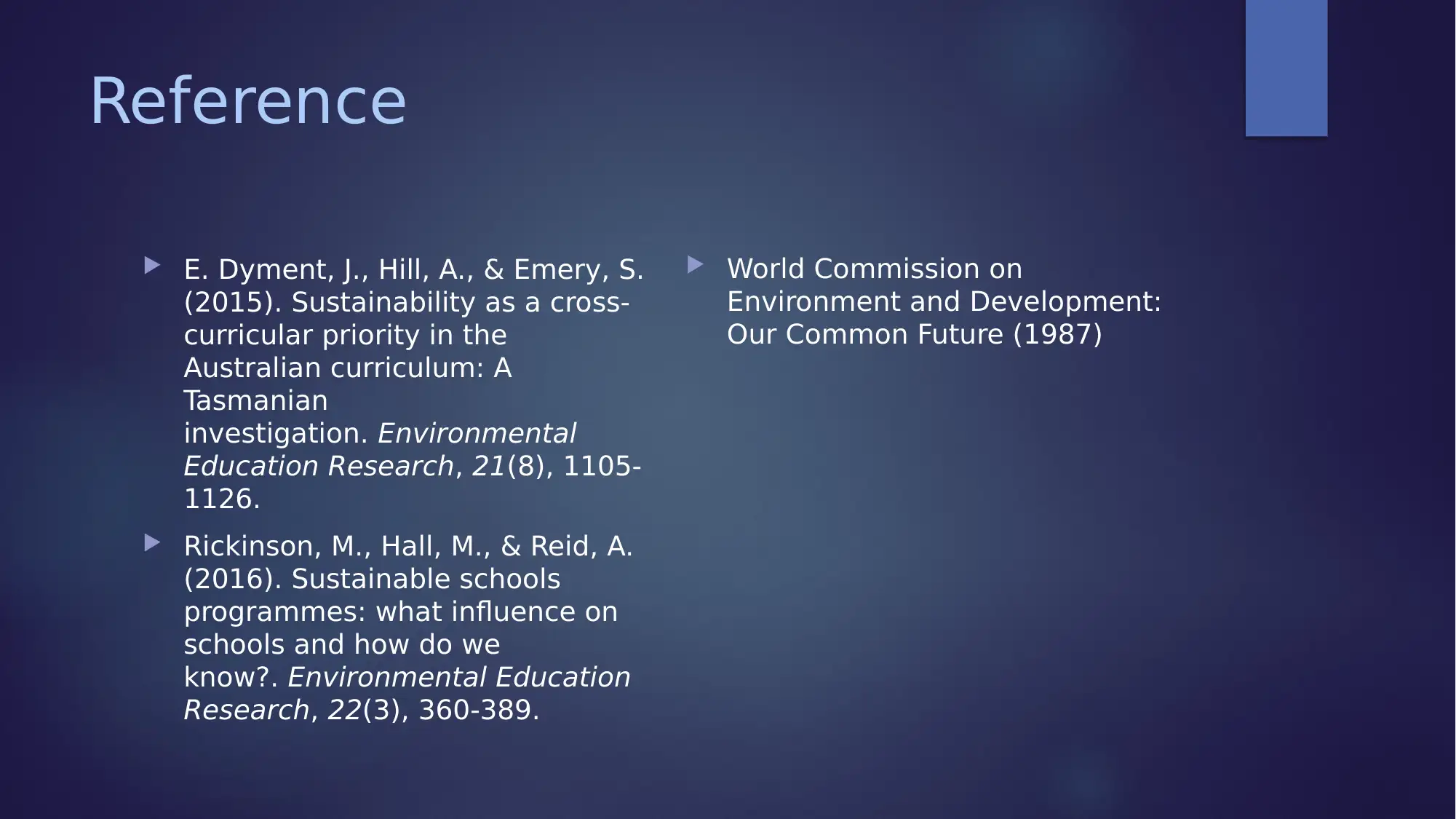
Reference
E. Dyment, J., Hill, A., & Emery, S.
(2015). Sustainability as a cross-
curricular priority in the
Australian curriculum: A
Tasmanian
investigation. Environmental
Education Research, 21(8), 1105-
1126.
Rickinson, M., Hall, M., & Reid, A.
(2016). Sustainable schools
programmes: what influence on
schools and how do we
know?. Environmental Education
Research, 22(3), 360-389.
World Commission on
Environment and Development:
Our Common Future (1987)
E. Dyment, J., Hill, A., & Emery, S.
(2015). Sustainability as a cross-
curricular priority in the
Australian curriculum: A
Tasmanian
investigation. Environmental
Education Research, 21(8), 1105-
1126.
Rickinson, M., Hall, M., & Reid, A.
(2016). Sustainable schools
programmes: what influence on
schools and how do we
know?. Environmental Education
Research, 22(3), 360-389.
World Commission on
Environment and Development:
Our Common Future (1987)
⊘ This is a preview!⊘
Do you want full access?
Subscribe today to unlock all pages.

Trusted by 1+ million students worldwide
1 out of 13
Related Documents
Your All-in-One AI-Powered Toolkit for Academic Success.
+13062052269
info@desklib.com
Available 24*7 on WhatsApp / Email
![[object Object]](/_next/static/media/star-bottom.7253800d.svg)
Unlock your academic potential
Copyright © 2020–2025 A2Z Services. All Rights Reserved. Developed and managed by ZUCOL.





